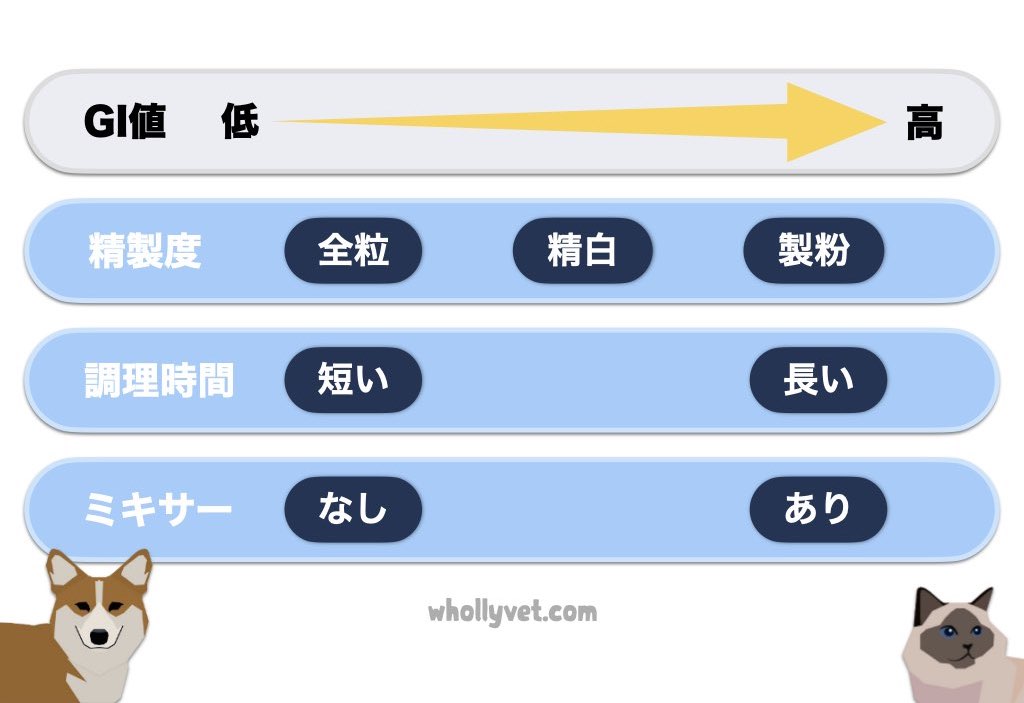グリセミック指数(GI値)は、炭水化物食品が血糖値をどれだけ上昇させるかを表しています。ブドウ糖(グルコース)を100とし、0〜100の数値で表します。

数値が低いほどよし
健康な犬と猫の手作り食では、肉や魚などのタンパク質食品がメインで、炭水化物食品はほとんど使いませんから、GI値を気にする必要はありません。
 これが基本!健康を守るためのワンちゃんの食事バランス
これが基本!健康を守るためのワンちゃんの食事バランス これが基本!健康を守るための猫ちゃんの食事バランス
これが基本!健康を守るための猫ちゃんの食事バランス
- 炭水化物食品を抜くと体重が必要以上に減ってしまう(小肝症など)
- 肥満、糖尿病、クッシング症候群など、メタボリックシンドロームで炭水化物を制限しなくてはいけないのに炭水化物しか食べてくれない
- 膵炎や膵外分泌不全、脂質代謝障害(高脂血症)のため、脂肪分を抑える代わりに炭水化物でカロリーを補いたい
 炭水化物ガイド
炭水化物ガイド
グリセミック・インデックス一覧
犬と猫の手作り食でよく使われている食品のGI値をリストアップしました。
ここに挙げたGI値は、主に人や実験動物の研究から計算された数値ですが、犬と猫でも同じような反応を示すことが報告されています。
▲を押すと順番を入れ替えることができます。
グリセミック・インデックス(GI値)は、50 g という一定量の炭水化物がどれくらいインスリン(血糖値)を上昇させるかを数値化したものです。
でも食品中の炭水化物含量は同じではありませんし、1回に摂取する量も異なります。例えば、白糖(スクロース)と白いごはんのGI値はほぼ同じですが、1食あたりの摂取量は白糖で小さじ一杯程度、白いご飯で茶碗一杯程度です。この場合、GI値は同じでも白米の方がインスリンを上昇させる能力が10倍近く高くなります。この摂取量や炭水化物含量を考慮したのがグリセミック・ロード(GL値)です。
GL = (GI × 1食分に含まれる炭水化物量)/ 100
果物は水分が多く、炭水化物含量も少ないので、一般的に穀類よりGL値が低くなります。
犬猫の手作り食では、砂糖などの甘いものは与えませんし、炭水化物食品も10〜30%未満に抑えるのが理想ですから、GI値を考慮すれば十分でしょう。

GI値が低いからといって食べすぎたら意味がないということですね。
調理方法の影響
GI値は分析方法、産地、製造方法、調理方法、調理時間、調理後の保存方法などによって変化します。例えば、お米。水分多めで長く炊くほどGI値が高くなります。より消化吸収されやすくなるためですね。粉にしたりミキサーで混ぜても同様の作用があります。

- Akanji AO et al. Dietary salt and the glycaemic response to meals of different fibre content. Euro J Clin Nutr 1989; 43: 699-703.
- Aston LM et al. Determination of the glycaemic index of various staple carbohydrate-rich foods in the UK diet. Euro J Clin Nutr 2008; 62(2): 279-85.
- Bahado-Singh PS et al. Food processing methods influence the glycaemic indices of some commonly eaten West Indian carbohydrate-rich foods. Br J Nutr 2006; 96: 476-81.
- Bornet FRJ et al. Insulinemic and glycemic indexes of six starch-rich foods taken alone and in a mixed meal by type 2 diabetics. Am J Clin Nutr 1987; 45: 588-95.
- Brand JC et al. Food processing and the glycemic index. Am J Clin Nutr 1985; 42: 1192-6.
- Brand-Miller J e tal. Rice: a high or low glycemic index food ? Am J Clin Nutr 1992; 56: 1034-6.
- Chan HMS et al. The glycaemic index values of Vietnamese foods. Euro J Clin Nutr 2001; 55: 1076-83.
- Crapo PA et al. Postprandial plasma-glucose and -insulin responses to different complex carbohydrates. Diabetes 1977; 26(12): 1178-83.
- Englyst KN et al. Glycaemic index of cereal products explained by their content of rapidly and slowly available glucose. Br J Nutr 2003; 89: 329-39.
- Ercan N et al. Plasma glucose and insulin responses to bananas of varying ripeness in persons with noninsulin-dependent diabetes mellitus. J Am Coll Nutr 1993; 12: 703-9.
- Gannon MC et al. The serum insulin and plasma glucose responses to milk and fruit products in Type 2 (non-insulin-dependent) diabetic patients. Diabetologia 1986; 29: 784-91.
- Granfeldt Y et al. Glucose and insulin responses to barley products: influence of food structure and amylose-amylopectin ratio. Am J Clin Nutr 1994; 59(5): 1075-82.
- Henry CJK et al. Glycaemic index and glycaemic load values of commercially available products in the UK. Br J Nutr 2005; 94: 922-30.
- Ito Y et al. Postprandial blood glucose and insulin responses to pre-germinated brown rice in healthy subjects. J Med Invest 2005; 52: 159-64.
- Jenkins DJA et al. Glycemic index of foods: a physiological basis for carbohydrate exchange. Am J Clin Nutr 1981; 34: 362-6.
- Jenkins DJA et al. Low glycemic response to traditionally processed wheat and rye products: bulgur and pumpernickel bread. Am J Clin Nutr 1986; 43: 516-20.
- Juliano BO et al. Properties of Thai cooked rice and noodles differing in glycemic index in noninsulin-dependent diabetics. Plant Foods Hum Nutr 1989; 39: 369-74.
- Matsuo T et al. Estimation of glycemic and insulinemic responses to short-grain rice (Japonica) and a short-grain rice- mixed meal in healthy young subjects. Asia Pacific J Clin Nutr 1999; 8(3): 190-4.
- Schauberger G et al. Exchange of carbohydrates according to their effect on blood glucose. Diabetes 1978; 26: 415 (abstr).
- Skrabanja V et al. Nutritional properties of starch in buckwheat products: studies in vitro and in vivo. J Agric Food Chem 2001; 49: 490-6.
- Soh NL, Brand-Miller J. The glycaemic index of potatoes: the effect of variety, cooking method and maturity. Euro J Clin Nutr 1999, 53: 249-54.
- Sugiyama M et al. Glycemic index of single and mixed meal foods among common Japanese foods with white rice as a reference food. Euro J Clin Nutr 2003; 57: 743-52.
- Sydney University Glycemic Index Research Service
- Thorburn A. Digestion and absorption of carbohydrate in Australian Aboriginal, Pacific Island and Western Foods. PhD thesis. Human Nutrition Unit, University of Sydney, Australia, 1986.
- Vahini J et al. Effect of processing and cooking on glycemic index of jowar varieties. Int J Food Nut Sci 2013; 2: 25-30.
- Wolever TMS et al. The glycemic index: similarity of values derived in insulin-dependent and non-insulin dependent diabetic patients. J Am Coll Nutr 1987; 6: 295-305.
- Yang YX et al. Glycemic index of cereals and tubers produced in China. World J Gastroenterol 2006; 12(21): 3430-3.

